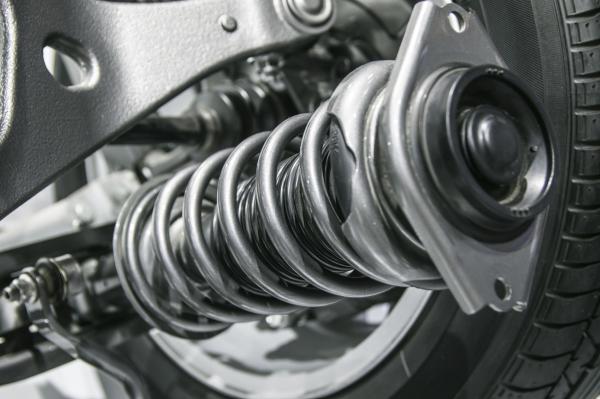How To Replace A Shock Absorber


Shock absorbers are integral parts of your car. They are pivotal in maintaining your car’s balance, so that you can always have an even and smooth ride. But like any other auto part, they wear out with time and even the smallest of potholes can cause damage. Driving on a busted shock absorber is unsafe as well as uncomfortable. You will know it’s time to replace your shock absorbers when you see oil leaking and your car constantly bobs. You can pay money for a mechanic to do the job for you, but with the right tools and knowledge you can learn toreplace them yourself. This oneHOWTO article is going to tell you how to replace a shock absorber at home.
Steps to follow:
When to replace your shock absorber
If your drive is not as smooth as before and the entire car rocks when it goes over a bump or pothole, then you probably need to replace your shock absorbers. Push down on the hood or trunk of your car right above the wheel. Look to see if it bounces up once and settles quickly. If the vehicle continues bouncing or if you cannot be pushed at all, then it’s time to get a new shock.
After suspending your vehicle with jacks, inspect the shock absorbers. If you see any fluid leaking or if the shocks seem to be dented, then they need replaced. Inspect the wheels as well, as worn out wheels will cause them to develop cupped wear, which will appear as low and high spots on the tire tread. After removing the shock absorber, try to compress it with your hand. If you can move it easily, then it must have gone bad. A good shock will have resistance when you compress it and extend on its own upon release.
Purchase new shock absorbers
While there are many variants, there are two main types of shock absorber. The first is the stand alone shock absorber and the other is part of the entire suspension strut. A strut is the structural component of the vehicle which is designed to reduce compression. Some cars may even have a combination of both. You need to determine the type of shock absorbers you need to buy. Stand-alone shocks are easier to replace, but if you have them integrated into the strut, then you should leave this complicated task to a professional.
Now that you are replacing your old shocks, it’s the right time to upgrade to the latest version. There are different types of shocks that you can buy as per your individual requirements and preferences:
- Reservoir shocks: Filled with fluid, these shocks are pressurized with nitrogen or air. As bounce is absorbed, the fluids come in contact with the gas, providing resistance and lubricating the spring.
- Coil shocks: These shocks have a coiled spring around them to provide support to the vehicle’s weight and control suspension. They can be adjusted as per the height of your vehicle.
- Monotube shocks: These shocks have two pistons and a tube and are a popular choice among heavy-duty vehicles like trucks.
- Twin-tube shocks: These shocks have two tubes with a piston in them, along with air and shock fluid surrounding it. These shocks affect the vehicle’s performance by releasing a frothy and foamy mixture. Some modern shocks may also release nitrogen mixture to further improve their performance.
Prepare the vehicle
Choose an appropriate location to start the process, park your car there on a level platform and loosen its lug nuts. Secure your car on jack stands or ramps, remove the tires and find the shock absorbers. You will find them near a horizontal or vertical bolt which you will need to unfasten and remove. Spray the mountings with a metal cleaner to loosen up the bolt if it is jammed.
Remove the old shock absorbers
This is the trickiest part, as the old shocks must be jammed with road grit and gunk. You may need to destroy the rubber around the bushings. Don’t worry, you are already changing the shocks anyway. The best thing you can do is to spray some PB Blaster or WD-40 in the area, let it sit for 10-15 minutes and then try to remove the old parts. Once you have located the shocks and loosened their parts, follow these steps to remove them:
- Some cars have top bolts located under the lining in their trunk. Lift up that fabric to reach the shock bolts and remove them using a socket and ratchet. Grease the bolts with a penetrating fluid to remove any rust from the surface and turn the ratchet and socket counter-clockwise to remove them.
- Use a nut splitter to disconnect the suspension from the nut and remove from the bolt. If you are not able to operate the splitter, apply some penetrating solvent in the area.
- Some cars also have a knuckle on the top of their brake assembly, which you also need to disengage before you can reach the shock.
- One challenge you might face is that the piston rod also turns as you loosen the nut. You may use locking pliers at the rod’s end to prevent it from turning and then loosen the nut using a wrench. If the nuts are too jammed to open up, spray some metal cleaner to let them loosen up and then try again.
As you can tell, proper lubrication is important. This is partly because your shock absorbers have worn out over time and have become tight.

Install new shock absorbers
Once you have removed the old shock absorbers, you need to follow these steps to install new ones:
- Affix the new shock absorbers back onto the suspension control system. Apply some pressure to fix the shock in place. Lift up the suspension so that the bolts which need to be reinstalled find their correct positions. Since this process needs some balancing, it would be better to get help from another person. Screw the nuts on with your hands as tight as possible.
- If you removed the anti-roll bar before, it’s time to fix it back. Reattach the anti-roll bar and screw up the bolts with your hands first. Replace shower tower nuts that you removed before. You must have found them in the trunk of your car.
- Refer to your car’s service manual to check the right torque specifications. Before you tighten and finalize everything, recheck your torque specs and ensure that all parts are safe and secure.
- Repeat all the above steps if you want to replace other shock absorbers in your vehicle as well. Most often, all four shock absorbers wear out evenly and at the same time. So, if you are replacing one, you should probably do them all
- After replacing all the shock absorbers, put the tires back, tighten the lugs and finish up the job.
Test drive the vehicle
After removing the jack, lower the car back to ground, remove wheel chocks and go for a short drive around the block. Listen to any noises during the drive. If you hear any pops or squeaks, then probably you have not tightened something correctly. If you cannot hear any noises, you will notice that the car rides better than before. If you are not sure how to replace the shock absorbers on your own, then it is advised to seek certified mechanic assistance from a professional. Some mechanics may even agree to come to your place to replace your shock absorbers at your convenient place and time.
If you want to read similar articles to How To Replace A Shock Absorber, we recommend you visit our Car Maintenance and Repair category.





